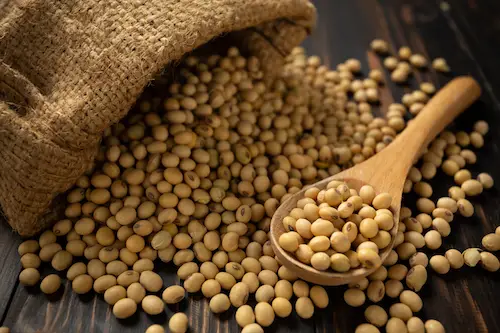This post contains affiliate links. When you buy through our links, we may earn a commission.

Can we prepare Miso without Soybeans? All about this Superfood!
 Miso is still very little used in Western cuisine, but it is becoming better known.
Miso is still very little used in Western cuisine, but it is becoming better known.
However, this type of fermented preparation is not the only one to cross the ages since we are already used to consuming fermented products such as cheese, yoghurts or sourdough bread.
There is a great variety of misos in the world just like the many cheeses in France. They are different according to the ingredients used and the maturing time.
The misos, based on soya, that we can easily find in the shops are the white miso and the red miso.
Miso paste is not the only soy-based food, we also know tofu, natto, tamari or tempeh.
Are you wondering if you can change the ingredients and replace the soybeans in miso?
Well yes, it is possible!
Soy is not your favorite ingredient in miso? You can replace it with other legumes that will bring you just as many health benefits!
Our miso recipe base will be all the more useful for you to make your own miso according to your preference!
Discover how to make homemade miso, its health and culinary benefits to give you inspiration in the kitchen.
What are the ingredients to make miso?
 Miso is a fermented soybean paste that has been used for centuries in Japan.
Miso is a fermented soybean paste that has been used for centuries in Japan.
The 3 main ingredients to make miso are koji* (fermented rice), salt and soybeans.
Traditional miso is made with soybeans but it can be made with other types of legumes such as white beans or chickpeas which are more easily available in stores.
Legumes other than soybeans are very interesting to try because they will develop a very particular taste.
- The advantages of making miso without soybeans are the following:
- White beans or chickpeas are more easily found in stores.
These legumes are much faster to cook than soybeans.
Miso is the best ingredient to prepare a good ramen. It is full of umami, which means that it has a rich, savory taste and can be used to enhance other flavors in your dish.
How to make miso paste?
The preparation of traditional miso is done in 2 steps:
- The first phase is the rice which will be fermented to obtain the koji.
- In a second step, the koji will continue to ferment with the soybeans.
Most often we use rice to make koji but it can also be prepared with barley koji.
The rice is steamed to obtain a sufficient moisture content and then the rice is inoculated with a fungus called aspergillus oryzae. This same fungus is found in cheeses such as Camembert or Roquefort.
Fermentation requires a little patience because the rice must ferment for a few days. However, the koji can be bought ready to make miso at home.
The koji rice is sold dehydrated in bags and can be found in organic or Japanese stores.
So, we are going to introduce you to the simplified version of homemade miso paste.
- 250 gr of dehydrated koji rice
- 150 gr of soybeans (or other legumes)
- 70 gr of fine salt (hymalaya pink salt)
- A little water
Steps to follow: :
- Start by washing the soybeans 2 or 3 times until they are clear. Cover the soybeans with water and let them sit overnight.
- The next day, cook the soybeans in a pot and cover 3 times the volume of soybeans with water. You can also steam the soybeans to save time.
- You obtain a seed that has lost its envelope, you can now pass the seeds in a sieve or a vegetable press to grind them and remove the film that envelops the seed.
- Place the koji rice in a bowl and mix it with the salt evenly.
- Then add the soybean puree to the mixture, add a little water and knead it to form a homogeneous paste.
- Place the miso paste in an airtight container, packing the paste well to remove air. Cover the dough with plastic wrap so that it sticks to the dough and seals it from the air. If your box is too big and there is still some space left, you can put a weight and close the lid.
Leave the container at room temperature for a few weeks and after 3 months you have miso paste ready to be eaten.
The amount of salt is quite high but it is essential for the preservation of miso.
What is white miso made of?
Miso paste comes in two forms:
- White miso, which has the texture and color almost identical to peanut butter,
- Red miso, which has a dark brownish color.
The white miso also called shiro miso is composed of the same ingredients as the traditional miso.
The maturation time of miso will give the yellowish color of white miso if it has fermented only a few weeks while red miso will have fermented at least 1 year up to 3 years.
We will thus obtain miso with a different taste.
White miso is rather sweet and mild, it can be used in recipes for spicy sauces and desserts but also in sauces, meat marinades, vegetable puree.
Red miso has a stronger taste and is very salty. It is a condiment that substitutes well to salt, it will give umami taste in meat stir-fry or soups by bringing an Asian touch.
Is miso good for my health?

Nutritionally, miso is a food condiment that is very rich in proteins, essential acids, vitamins B and K and also in omega 3.
It is a super food of choice, especially for vegetarians and vegans, and helps to overcome the most common deficiencies. Its vitamins and amino acids are not present in plants.
As a fermented food, it contains probiotics that help keep the intestine healthy and facilitate digestion.
Fermented rice and soybeans have antioxidant properties.
Consumption of miso helps to protect us from the formation of free radicals.
Miso helps to reduce menopausal symptoms thanks to its isoflavones.
The soy contained in miso prevents cardiovascular risks.
However, soy has been controversial for years regarding its harmful effects on breast cancer. No significant study to date shows the effects of soy on health.
However, the French Food Safety Agency (Anses) recommends not to exceed 1 mg of isoflavones per kilo of body weight per day. This means that a person weighing 60 kg should not ingest more than 60 mg of isoflavones per day, knowing that 100 g of soy foods (tofu, soy desserts, etc.) provide between 10 and 30 mg.
Miso paste should be consumed in moderation.
How to make miso paste liquid?
 Simply dissolve a tablespoon of miso paste in a liquid to prepare your sauces or soups.
Simply dissolve a tablespoon of miso paste in a liquid to prepare your sauces or soups.
This way, the paste will blend more easily into the mixture.
Miso paste is a rather salty condiment so be careful even if it is an ingredient full of benefits, it is best enjoyed in small doses and as a replacement for salt!
What temperature can kill the benefits of miso?
Miso is a living food and like all yeast that is heated above 100°F , it loses its nutritional qualities.
We recommend that you add miso at the end of your preparation when making soups.
Can I lose weight with miso soup?
You will certainly not melt away weight by consuming miso.
However, it helps to bring umami, a strong taste and a particular flavor to your dishes. It is a good ally for slimming down your recipes without losing the taste in your plate.
It is a super food rich in vitamins and facilitating digestion, so it can contribute to your weight loss process.
How long does miso keep?
Miso can be stored indefinitely in the refrigerator if you do not intend to use it within a few days.
It is always better to adapt the quantities you prepare to your consumption and to make a new miso paste if needed so that it keeps its taste.
Recipe Light White Miso Sauce

Ingredients You Need :
- 1 yogurt (or soy yogurt)
- 2 tablespoons of mustard
- 2 tablespoons of sesame oil
- 2 tablespoons of mirin
- 2 tablespoons of white miso
Steps to follow: :
- Start by diluting the white miso with the mirin and sesame oil, then add the rest of the ingredients.
- This creamy sauce can be eaten with dips, in a sandwich or a salad.
Conclusion
When you make it yourself, miso has a better taste and you can change its composition by replacing soybeans with other legumes.
Miso is one of those foods that you either love or hate. It can have a strong taste indeed but if you make a fermented miso for 3 weeks, you will get a sweet, salty taste better appreciated.
It can be used in many ways to enhance your dishes, you just have to let your imagination run wild.
In a few minutes, you can make a miso soup with the ingredients of your choice and an exquisite umami flavor. Do not hesitate any longer!
